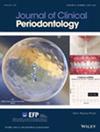The Association of Periodontitis With Risk of Prevalent and Incident Metabolic Syndrome.
IF 6.8
1区 医学
Q1 DENTISTRY, ORAL SURGERY & MEDICINE
引用次数: 0
Abstract
AIM To investigate whether periodontitis is associated with prevalent and incident metabolic syndrome (MetS). MATERIALS AND METHODS The baseline study included 4183 individuals from a population-based survey (DILGOM) in 2007 and follow-up of 1047 participants with clinical re-examination in 2014. The risk of periodontitis was assessed with saliva biomarkers using a validated, three-group cumulative risk score for periodontitis (CRS I, II and III). RESULTS In fully adjusted models, CRS III was associated with prevalent MetS (OR: 1.35, 95% CI [1.11-1.65]), high waist circumference (1.55 95% CI [1.26-1.91]), high blood pressure (1.29 95% CI [1.05-1.59]) and the number of MetS components (β: 0.18, 95% CI [0.06-0.30]). Among participants without MetS at baseline (n = 618), 128 (20.7%) developed MetS during follow-up. In the fully adjusted model, CRS III trended positively with incident MetS (RR: 1.55, 95% CI [ 0.96-2.51]) in the whole population and had a significant positive association in women (2.06, 95% CI [1.08-3.94]), and in non-smokers (1.78, 95% CI [1.01-3.14]). The risk between CRS and incident MetS was mediated via systemic inflammation. CONCLUSION Periodontitis is associated with an increased risk of having metabolic syndrome and, in particular, clearly with the number of MetS components: abdominal obesity, hyperglycaemia and hypertension. Systemic inflammation may elucidate the observed higher risk of incident MetS.牙周炎与流行和偶发代谢综合征风险的关系。
目的探讨牙周炎是否与代谢综合征(MetS)相关。材料和方法基线研究包括2007年基于人群的调查(DILGOM)中的4183人,以及2014年临床复查的1047名参与者的随访。使用唾液生物标志物评估牙周炎的风险,使用经过验证的三组牙周炎累积风险评分(CRS I, II和III)。结果在全校正模型中,CRS III与met发生率(OR: 1.35, 95% CI[1.11-1.65])、高腰围(1.55 95% CI[1.26-1.91])、高血压(1.29 95% CI[1.05-1.59])和met成分数量(β: 0.18, 95% CI[0.06-0.30])相关。在基线时无MetS的参与者中(n = 618), 128(20.7%)在随访期间发生MetS。在完全调整后的模型中,整个人群的CRS III与met事件呈正相关(RR: 1.55, 95% CI[0.96-2.51]),在女性(2.06,95% CI[1.08-3.94])和非吸烟者(1.78,95% CI[1.01-3.14])中呈显著正相关。CRS和met之间的风险是通过全身炎症介导的。结论:牙周炎与代谢综合征的风险增加有关,特别是与代谢代谢综合征组成部分(腹部肥胖、高血糖和高血压)的数量明显相关。全身性炎症可能解释了观察到的较高的MetS发生风险。
本文章由计算机程序翻译,如有差异,请以英文原文为准。
求助全文
约1分钟内获得全文
求助全文
来源期刊

Journal of Clinical Periodontology
医学-牙科与口腔外科
CiteScore
13.30
自引率
10.40%
发文量
175
审稿时长
3-8 weeks
期刊介绍:
Journal of Clinical Periodontology was founded by the British, Dutch, French, German, Scandinavian, and Swiss Societies of Periodontology.
The aim of the Journal of Clinical Periodontology is to provide the platform for exchange of scientific and clinical progress in the field of Periodontology and allied disciplines, and to do so at the highest possible level. The Journal also aims to facilitate the application of new scientific knowledge to the daily practice of the concerned disciplines and addresses both practicing clinicians and academics. The Journal is the official publication of the European Federation of Periodontology but wishes to retain its international scope.
The Journal publishes original contributions of high scientific merit in the fields of periodontology and implant dentistry. Its scope encompasses the physiology and pathology of the periodontium, the tissue integration of dental implants, the biology and the modulation of periodontal and alveolar bone healing and regeneration, diagnosis, epidemiology, prevention and therapy of periodontal disease, the clinical aspects of tooth replacement with dental implants, and the comprehensive rehabilitation of the periodontal patient. Review articles by experts on new developments in basic and applied periodontal science and associated dental disciplines, advances in periodontal or implant techniques and procedures, and case reports which illustrate important new information are also welcome.
 求助内容:
求助内容: 应助结果提醒方式:
应助结果提醒方式:


